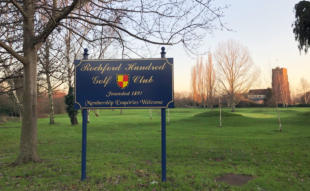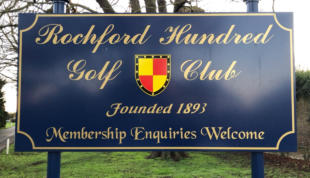With
outstanding
golf
courses
in
the
area,
it
is
perhaps
not
really
surprising
that
golf
is
such
a
popular
sport
in
Southend.
Yet
golf
in
Southend began in much humbler surroundings.
Rochford
Hundred
Golf
Club
opened
in
1896,
but
its
history
dates
three
years
earlier
with
the
Southend-on-Sea
Golf
Club
which
was
formed
in
the
summer
of
1893.
At
this
time,
golf
was
just
beginning
to
flourish
in
the
South,
but
as
a
rule,
it
was
looked
on
by
most
as
“an
old
man’s
game,”-
something
to
be
taken
up
when
too
old
for
games
of
a
more athletic nature. How different from current times.
In
the
spring
of
1893,
several
men
among
whom
were
Messers.
Warlow,
Turner,
W.
Walker,
R.
B.
Campbell,
and
Dr.
Silva
Jones,
decided
to
form
a
club.
A
tentative
start
was
made
by
laying
out
a
course
of
six
holes
on
the
field
at
the
back
of
the
Rectory
at
Southchurch
–
but
this
“course”
was
probably
more
pitch
and
putt
as
we
know
it
rather
than
golf.
A
few
months
later,
three
fields
were
rented
on
the
Southchurch
Hall
Farm
–
the site where the Kursaal was – and the Southend-on-Sea Golf Club was inaugurated.
In
the
beginning
the
course
seemed
very
promising.
It
had
been
a
very
dry
season
and
consequently
the
grass
was
very
short.
The
turf
seemed
suitable
for
golf.
The
headquarters
were
at
the
Ship
Hotel,
where
a
room
was
provided
as
a
club
room.
A
good
many
golfers
from
London
joined,
probably
attracted
by
the
“on-Sea”
and
under
the
impression
that
it
was
a
seaside
course,
the
links
were
used
by
red
coats
at
weekends.
Anyone
with
pretensions
to
being
a
player
in
those
days
wore
a
red
coat,
and
if
you
went
round
in
under
100,
you
were
considered
entitled
to
wear
it.
However,
with
the
winter
came
disillusion:
the
course
became
a
veritable
swamp.
The
first
hole,
about
180
yards,
was
“casual
water”
from
tee
to
hole.
It
became
known
as
“Warlow’s
Bath
–
the
reason
being
that
Mr
Warlow,
the
Hon
Secretary,
while
superintending
the
cutting
of
a
trench
to
try
and
drain
it,
fell
into
it.
Cattle
grazed
on
the
course,
with
the
result
that
shots
often
had
to
be
made
out
of
hoof
marks
and
often
balls
were
lost.
The
course
was
one
of
nine
holes
and
Mr
Walker
was reckoned the holder of the 18 hole record with 87. Most players took nearly as many strokes for nine holes.
In
1896
the
club
fell
on
bad
times.
The
London
members
had
all
resigned,
finances
were
low,
and
the
grass
grew
very
long
–
there
were
no
facilities
for
getting
it
cut.
When
the
Gas
Company
built
a
gasometer
on
the
last
green
and
the
Corporation
started
to
cut
a
drain right across the the course, it seemed goodbye to golf in Southend.
At
that
time
the
guiding
spirits
were
Messers.
W.
Walker,
F.
Davidson,
W.
M.
Grimshaw,
C.
F.
Woosman,
D.
S.
Edwards
and
the
Rev.
E.
E.
Kimber.
Search
was
made
for
suitable
land
around
in
the
neighbourhood,
but
without
success.
At
this
point,
a
Mr
Tabor
made
an
offer
of
land
around
Rochford
Hall
Farm,
plus
the
use
of
two
rooms
in
the
Hall.
His
offer
was
gratefully
accepted
and
at
a
meeting
in the Ship in November 1896, the club was wound up and Rochford Hundred Golf Club came into being.
At
the
time
the
club
started
at
Rochford,
there
were
only
80
members
at
a
subscription
of
one
guinea
and
a
few
ladies
at
10s
6d.
Assets
consisted
of
about
£10
at
the
bank,
one
roller
and
one
mowing
machine.
It
was
only
through
the
generosity
of
Mr
Tabor
letting
the
land
practically
rent
free
that
a
start
was
possible.
Only
nine
holes
were
laid
out
at
first,
all
on
the
north
side
of
the
stream
which
was
designed
by
Peter
Paxton
of
Tooting
Bec.
Mr
Walker
was
Captain,
Mr
Davidson
Hon.
Secretary
and
Walter
Toogood
was
appointed
professional
and
greenkeeper.
The
links
were
officially
opened
on
Boxing
Day
1896,
and
the
first
ball
was
driven
by
Mr
James Tabor, who was presented with a silver cleek as a memento.
In
1903,
when
a
change
in
the
manufacture
of
golf
balls
made
it
easier
to
hit
the
ball
harder,
some
holes
were
changed
to
give
the
course,
which
had
extended
to
18
holes
in
1898,
more
distance.
To
inaugurate
this,
a
professional
competition
was
arranged
and
the
legendary
Harry
Vardon
was
amongst
those
who
took
part.
From
this
point,
until
1923, there were no great changes in the course at Rochford.
In
1923
the
course
was
reconstructed
by
the
well-known
architects
Messers.
Hawtree
and
Taylor,
with
the
aid
and
advice
of
Mr
James
Braid.
The
club
house
at
Rochford,
was
now
the
formerly
Rochford
Hall,
which
was
the
residence
of
Sir
Thomas
Boleyn.
The father of Anne Boleyn, the second Queen of Henry VIII.
In
1913
it
was
decided
to
lay
out
a
second
course
at
Rochford
because
of
the
popularity
the
game
was
enjoying.
The
making
of
the
new
course
was
in
the
hands
of
Messers.
Kemsley
and
J.
Steel.
It
was
opened
for
play
1915
but
the
First
World
War
prevented
it
being
developed any further, and in January 1918, the Government, on account of the food shortage, ordered it to be ploughed up.
The
course
at
Thorpe
Hall
Golf
Club
was
laid
out
in
in
1906
by
Mr
K.
Costly
White,
assisted
by
club
professional
Mr
Bert
Batley.
The
Hall,
which
was
converted
into
the
club
house,
dates
from
1668.
Since
the
Thorpe
Hall
course
was
first
constructed
many
improvements
have
taken
place
and
the
last
three
holes
were
completely
remodelled
during
1936.
In
a
1939
Southend
Guide,
Thorpe
Hall,
is
described
as”
the
nearest
seaside
holiday
course
to
London,”
while
other
local
course,
Belfairs,
with
its
infamous
wood
holes,
is
described
as
“one
of
the
most
beautiful
courses
in
East
Anglia.”
In
the
same
guide
Rochford
is
described
as
ensuring
a
“wonderful
diversity of tests for every class of golfer.”


Southend Golf Club

Southend Timeline Southend-on-Sea © 2009 - 2024. All Rights Reserved



Southend-on-Sea’s No 1 History Website! Documenting The Town & The Townspeople
Now Incorporating The Sea Of Change Website
Website Info:



SOUTHEND CITY
Chalkwell ▪ Eastwood ▪ Leigh-on-Sea ▪ Prittlewell ▪ Shoeburyness ▪ Southchurch ▪ Thorpe Bay ▪ Westcliff-on-Sea
































































